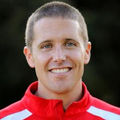“Aches, pains and health issues are just a part of getting older.”
“I’m too old to start exercising now.”
You’ve likely heard these statements at some point in your life, and maybe you’ve even started to repeat them as you've gotten older. Common as they are, these statements are more like myths. You can improve your physical well-being in your older adult years even if you’ve never exercised before.
It’s not how old you are, it’s how much you move. The U.S. Department of Health and Human Services suggests adults do at least two-and-a-half to five hours a week of moderate-intensity activity. Focusing on the postural alignment of your body may also help you start feeling better and moving with confidence. Proper postural alignment helps with everything from cardiovascular health to relieving joint pain and arthritis (Wannamethee et al., 2006).
When you’re young and continuing that habit throughout your life improves your health and decreases your chances of death. But a recent study found the same is true for adults who start exercising later in life. (Saint-Maurice, Coughlan and Kelly, 2019).
According to the study’s authors, “Although long-term participation in physical activity may be important to lower mortality risk, the present study provides evidence that becoming physically active later in adulthood (40-61 years of age) may provide comparable health benefits.”
Other scientific studies have uncovered similar conclusions, including the fact that exercise programs for sedentary middle-aged adults can help to decrease the risk of heart disease (Howden, 2018).
Now that you understand that exercise can help you turn around your health at any age, the next step is figuring out what activities you enjoy and will stick with over the long term.
Rethink Fitness
Starting exercise later in life requires that you find more meaning in why you’re moving. For example, can you transition from standing, down to the floor, and back up again easily? How do you feel when you get out of your car? Do you feel sluggish when you’ve been sitting for a long period of time? Ask yourself these questions and start to reshape your fitness goals to enhance your day-to-day functions in life and the confidence you have in your body.
Make Exercise a Fun Habit
Choose activities that you enjoy, which will make it much easier for you to stick with your exercise routine. Get your family involved by going on a hike or a walk around the neighborhood. Dance with your grandkids in the kitchen, play a game of pickleball with friends or go for a swim at your nearby gym. Willpower will only get you so far, so find a way to make exercise a new routine for your daily life. Reward yourself for exercising so you’re motivated to do it again.
The bottom line: The earlier you start the better, so start today.
References
Howden, E.J., et. al. (2018). Reversing the cardiac effects of sedentary aging in middle age—A randomized controlled trial. American Heart Association Journal, 137, 15, 1549-1560.
Saint-Maurice, P.F., Coughlan, D., Kelly, S.P., (2019). Activity Across the Adult Life Course With All-Cause and Cause-Specific Mortality. Jama Network Open, 2, 3, e190355.
Wannamethee, S.G. et al. (2006) Height loss in older men: Associations with total mortality and incidence of cardiovascular disease. US National Library of Medicine National Institutes of Health, 166, 22, 2546-2552.




 by
by 









 by
by